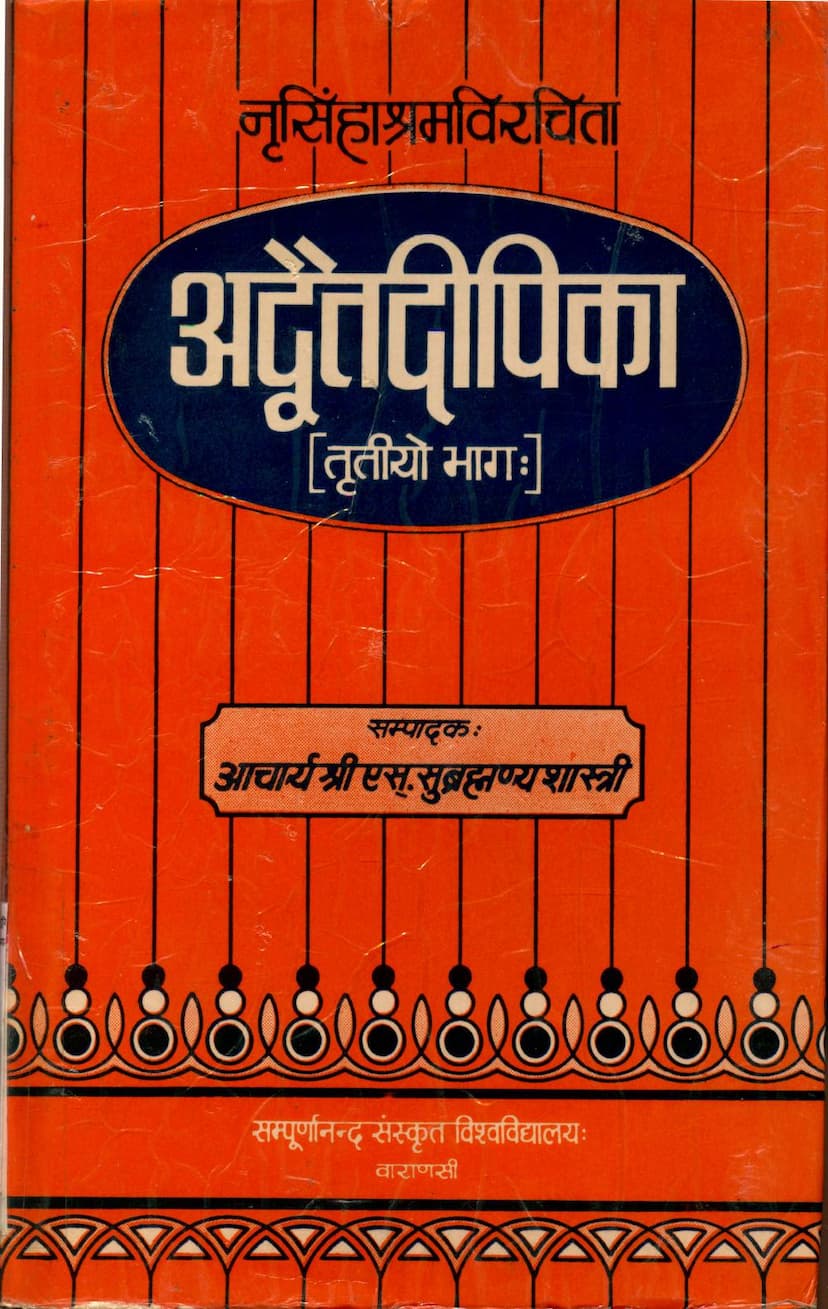Adwait Dipika Part 03
Added to library: September 1, 2025

Summary
This is a summary of "Adwaita Deepika Part 03," a Jain text authored by S. Subramanya Shastri and published by Sampurnanand Sanskrit Vishvavidyalaya. This particular volume is Part Three of a larger work, with a commentary titled "Advaitadipikavivaranam" by Narayanasrama.
The publication details indicate it is Volume 118 of the Sarasvati Bhavana-Granthamala series. The foreword, written by the Vice-Chancellor of Sampurnanand Sanskrit University, highlights the significance of this conclusive volume and expresses gratitude for the scholarly efforts of the editor, S. Subramanya Sastri. It also mentions the auspicious occasion of its release by His Holiness Chandrasekharendra Sarasvati. The foreword further delves into the historical context of Nrisimhasrama, the original author, noting his importance in the philosophical debates between Dvaita, Advaita, and Vishishtadvaita Vedanta, and his association with Kashi. It also points out the author's skillful use of satire and wit in engaging with philosophical opponents.
The main body of the text, as presented in the provided pages, appears to be an "Upoadghata" (Introduction) to the fourth "Pariccheda" (Chapter) of Nrisimhasrama's "Adwaita Deepika." The primary purpose of this introduction is to explain that this work aims to provide solutions to the criticisms of Advaita Vedanta found in Jayatirtha's "Nyayasudha."
The text then elaborates on key Advaitic concepts and refutes opposing viewpoints, particularly those of Dvaita and Vishishtadvaita. It emphasizes:
- The Authority of Shruti (Vedas): The work stresses that the Upanishads and other Vedic texts are the primary source of truth, and their teachings should be upheld.
- The Nature of Brahman: It argues that Brahman is singular, non-dual ("Ekam evadvitiyam Brahma"), and the ultimate reality.
- The Role of Maya: The concept of Maya is discussed as the power that creates the illusion of multiplicity.
- The Relationship between Jiva and Brahman: A central theme is the non-duality of the individual soul (Jiva) and Brahman, supported by Mahavakyas like "Tat Tvam Asi" and "Aham Brahmasmi."
- Refutation of Dvaita and Vishishtadvaita Arguments: The text systematically addresses and counters arguments from Dvaita (dualism) and Vishishtadvaita (qualified non-dualism), particularly concerning the interpretation of key Upanishadic passages and Brahma Sutras.
- The Nature of Liberation (Moksha): Moksha is described as the realization of one's true self, which is identical with Brahman, leading to the cessation of ignorance and suffering. The text refutes the idea of liberation as mere attainment of a heaven like Vaikuntha, emphasizing the importance of realizing one's own essential nature.
- The Doctrine of Vivarta: The concept of Vivarta (transformation without essential change) is presented as the correct explanation for the manifestation of the world from Brahman, as opposed to Parinama (actual transformation).
- The Interpretation of Key Passages: Significant portions are dedicated to interpreting specific Upanishadic statements and Brahma Sutras (like "Janmadyasya yatah," "Tat tvam asi," "Aham Brahmasmi," and passages from the Brihadaranyaka and Chandogya Upanishads) to support the Advaita position.
- The Nature of Real and Apparent Truth: The distinction between ultimate reality (Paramarthika) and empirical reality (Vyavaharika) is discussed, where the empirical world is considered real for practical purposes but ultimately illusory when viewed from the perspective of ultimate truth.
- The Nature of Testimony (Shabda): The text engages in a detailed philosophical discussion on the nature of language and how words refer to reality, particularly in the context of Advaita. It explores the concepts of 'shakti' (primary meaning) and 'lakshana' (secondary meaning) in understanding the ultimate nature of Brahman, which is often described as beyond direct linguistic description.
The "Upoadghata" section is particularly extensive, engaging in a rigorous analysis of various philosophical arguments and interpretations of Vedic texts to establish the Advaita viewpoint. It systematically refutes perceived flaws in opposing arguments and defends the Advaitic understanding of scripture and reality. The text showcases a deep engagement with Mimamsa and Nyaya principles in its philosophical discourse.
In essence, "Adwaita Deepika Part 03," and its accompanying introduction, serves as a comprehensive defense and explication of Advaita Vedanta, aiming to clarify its doctrines and refute alternative philosophical interpretations, particularly those that propose duality or qualified non-duality.